
Pensacola is the westernmost city in the Florida Panhandle, and the county seat and only incorporated city of Escambia County, Florida. Pensacola is the principal city of the Pensacola Metropolitan Area, which had an estimated 502,629 residents in 2019. At the 2020 United States census, the population was 54,312.

Warrington is a census-designated place (CDP) in Escambia County, Florida, United States. Warrington is located between downtown Pensacola and the state line with Alabama; it is 6 miles (10 km) away from both.

Pensacola High School is a secondary school located near downtown Pensacola, Florida, United States.
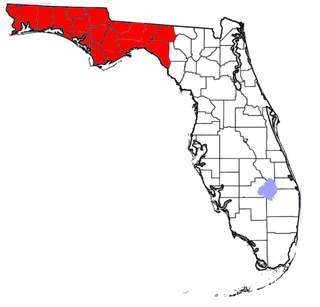
The Florida Panhandle is the northwestern part of the U.S. state of Florida. It is a salient roughly 200 miles long, bordered by Alabama on the north and the west, Georgia on the north, and the Gulf of Mexico to the south. Its eastern boundary is arbitrarily defined. It is defined by its southern culture and rural geography relative to the rest of Florida, as well as closer cultural links to French-influenced Louisiana, Mississippi, and Alabama. Its major communities include Pensacola, Navarre, Destin, Panama City Beach, and Tallahassee.

Naval Air Station Pensacola or NAS Pensacola, "The Cradle of Naval Aviation", is a United States Navy base located next to Warrington, Florida, a community southwest of the Pensacola city limits. It is best known as the initial primary training base for all U.S. Navy, Marine Corps and Coast Guard officers pursuing designation as naval aviators and naval flight officers, the advanced training base for most naval flight officers, and as the home base for the United States Navy Flight Demonstration Squadron, the precision-flying team known as the Blue Angels.
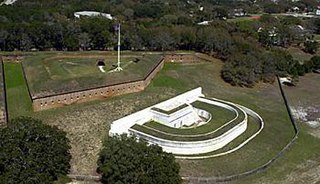
Fort Barrancas (1839) or Fort San Carlos de Barrancas is a United States military fort and National Historic Landmark in the former Warrington area of Pensacola, Florida, located physically within Naval Air Station Pensacola, which was developed later around it.
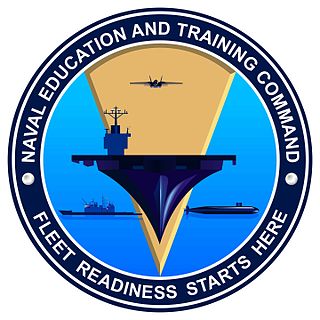
The Naval Education and Training Command (NETC) is an enterprise level shore command of the United States Navy with more than 19,000 military and staff personnel at more than 1,640 subordinate activities, sites, districts, stations, and detachments throughout the world.
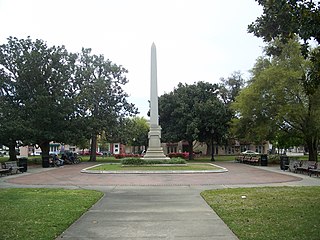
The Plaza Ferdinand VII is an outdoor garden and park in the Historic Pensacola Village area of downtown Pensacola, Florida. It is located on Palafox Street between Government and Zaragoza Streets. It was named after Ferdinand VII of Spain, the King of Spain between 1813 and 1833. A National Historic Landmark, it is the site of the formal transfer of Florida to United States jurisdiction in 1821.

Barrancas National Cemetery is a United States National Cemetery located at Naval Air Station Pensacola, in the city of Pensacola, Florida. It encompasses 94.9 acres (38.4 ha), and as of 2021 had over 50,000 interments.

The Pensacola Hospital was a hospital in Pensacola, Florida, United States, located at 1010 North 12th Avenue. On February 16, 1982, it was added to the United States National Register of Historic Places.

Donald Marshall Carpenter was an early naval aviator in the United States Navy flying from the USS Langley (CV-1) and USS Lexington (CV-2). These were the first two aircraft carriers of the U.S. Navy. He graduated from the U. S. Naval Academy in the Class of 1916 representing Pennsylvania. He is the namesake of the USS Carpenter (DD-825).

Naval Air Station Key West, is a naval air station and military airport located on Boca Chica Key, four miles (6 km) east of the central business district of Key West, Florida, United States.
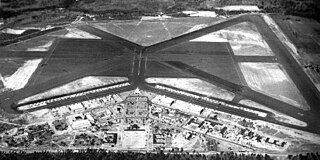
Saufley Field is a military airport and support facility located in unincorporated Escambia County, Florida, United States, five nautical miles (9 km) west of the central business district of Pensacola.

Marine Corps Air Station Kaneohe Bay or MCAS Kaneohe Bay is a United States Marine Corps (USMC) airfield located within the Marine Corps Base Hawaii complex, formerly known as Marine Corps Air Facility (MCAF) Kaneohe Bay or Naval Air Station (NAS) Kaneohe Bay. It is located two miles northeast of the central business district of Kaneohe, in Honolulu County, Hawaii, United States. The airfield has one runway (4/22) with a 7,771 x 200 ft asphalt surface.
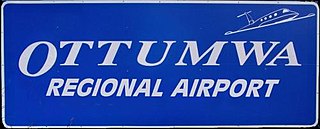
Ottumwa Regional Airport, formerly Ottumwa Industrial Airport, is six miles northwest of Ottumwa, in Wapello County, Iowa. The airport is owned by the City of Ottumwa and is operated by the Airport Advisory Board. It is listed as a general aviation airport in the National Plan of Integrated Airport System (NPIAS) and as an Enhanced Service Airport in the Iowa Aviation System Plan.


Chevalier Field was the original non-seaplane aircraft landing area at Naval Air Station Pensacola, Florida. Established originally in 1922 as Station Field, it was an expansion of the balloon operating field that opened in 1916. It was located on the northeast side of the Navy shipyard, on the western edge of Pensacola Bay and south of Bayou Grande. The small town of Woolsey, just north of the Navy Yard, had been razed for the creation of the airdrome. "Locals assumed the Army's involvement in the project and had to be informed that the field, initially called Station Field, was intended for the exclusive use of Navy landplanes."

Charles Perry Mason was a highly decorated officer in the United States Navy with the rank of Vice admiral. An early naval aviator, he distinguished himself as Commanding officer of aircraft carrier USS Hornet (CV-8), which was sunk during the Battle of the Santa Cruz Islands in late October 1942. Mason was subsequently promoted to Rear admiral and served successively as Commander, Aircraft, Solomons and Chief of the Naval Air Intermediate Training Command at Naval Air Station Pensacola, Florida.

On the morning of December 6, 2019, a terrorist attack occurred at Naval Air Station Pensacola in Pensacola, Florida. The assailant killed three men and injured eight others. The shooter was killed by Escambia County sheriff deputies after they arrived at the scene. He was identified as Mohammed Saeed Alshamrani, an Air Force aviation student from Saudi Arabia.
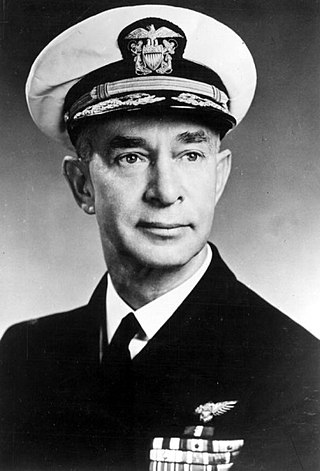
Frank Dechant Wagner was a highly decorated Naval aviator in the United States Navy with the rank of Vice Admiral. A Naval Academy graduate, Wagner distinguished himself as Commander of Patrol Wing Ten during operations against the enemy in the early weeks of the Japanese Invasion of the Philippines. He was then promoted to the general officer's rank and served as Commander, Aircraft, Seventh Fleet during liberation of the Philippines in 1944–1945.
























